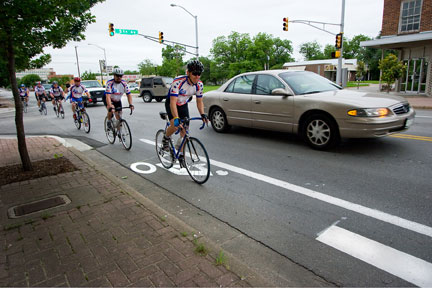After years of inaction, Fort Worth, the land of pickup trucks and SUVs, may finally be ready to pump some air into the tires of a citywide bike system.
The city has had a bike plan of sorts on the books for a decade, but that’s mostly where it stayed – on paper, not on the streets. Thanks to rising gas prices, bicycle riders who raised Cain at city council meetings, and the work of a bike-savvy new planner, however, this one looks like it has a better chance of actually being implemented. It’s a $113 million, 20- to 30-year scheme for various kinds of bikeways, from riverside trails to heavily trafficked streets, that would enable Cowtonians to ride their two-wheelers not only to parks but also to work, to the store, and even to Dallas. After a few more tweaks, officials hope to take it to the city council for approval in late summer and then to start looking for regional, state, and federal grants to help fund the work.
 The new plan assumes residents will use bikes for more than just recreation. It calls for almost 500 miles of dedicated bike lanes along city streets, as well as off-road trails that would eventually connect Fort Worth cyclists to every city in Tarrant County and, further, to the “Veloweb” of bikeways reaching across the Metroplex.
The new plan assumes residents will use bikes for more than just recreation. It calls for almost 500 miles of dedicated bike lanes along city streets, as well as off-road trails that would eventually connect Fort Worth cyclists to every city in Tarrant County and, further, to the “Veloweb” of bikeways reaching across the Metroplex.
“This isn’t going to happen overnight,” said James Wilson, president of the Lockheed Martin Recreation Association Bicycle Club and one of the first people to petition the city for a bike plan.
Wilson, a member of Fort Worth’s Bicycle Study Technical Committee and, as of Saturday, a member-elect of the Benbrook City Council, said some cyclists were skeptical at first when senior planner Don Koski approached them about reviving the bike plan.
The “Bike Fort Worth” document also underscores the idea of cycling as an integral part of the transportation system by including a downtown bike commuter station, with fenced areas where cyclists could park their bikes and hop buses or trains to more-distant destinations. The T already has bike racks on all of its buses, and bikes are also allowed on the Trinity Railway Express.
It’s the same concept underlying a piece of federal legislation called the Complete Streets Act – a bill, introduced in both houses of Congress, that would require states and cities to keep bikers, pedestrians, and public transit users in mind when planning roads.
“Eventually this will be standard practice,” Koski said.
Fort Worth had a bike plan of sorts in 1999. Called the Bicycle Blueprint, it was touted to the U.S. Environmental Protection Agency as a supposed part of the city’s effort to clean up its air-pollution problem.
However, the city council was never given a full briefing on it, and city staffers didn’t submit proper paperwork to the Texas Department of Transportation to win state funding. Some city leaders only heard about the plan when cyclists like Wilson showed up at council meetings to complain about the inaction.
“Between 1999 and 2005 they [the city] said great things but didn’t really do anything,” Wilson said.
In late 2006, a few months after the bikers started coming to council meetings, the city hired Koski as a senior planner in its transportation and public works department. Koski won the trust of the local cycling community, based on his background in urban bike planning and on his willingness to get on a bike and ride most of the miles of routes and trails in the original blueprint.
Beginning in 2007, a study committee made up of bikers as well as representatives of city departments and other government agencies has helped put the new plan together. Members from Tarrant County, The T, Texas Christian University, and the Trinity River Vision project are included. This time around, the council has already been briefed several times and, Koski said, has shown support. He’s confident the council will approve the plan.
Over the next few decades, the plan, if implemented, would exponentially increase the miles of roads and paths now designated for cyclists in Fort Worth. Several types are included: Bike routes are city streets where signs alert motorists to the fact that bike-riders are sharing the pavement with them. Bike lanes refer to striped-off, bike-only lanes, which in many cases would require the widening of streets. Bike trails and bike paths, sometimes gravel or dirt, sometimes paved, lead away from city streets through parks and along rivers and other routes, such as converted railroad rights of way. And bikeways is a catch-all term referring to all those possibilities.
The plan would increase the city’s current 40 miles of bike routes to about 224 miles. Bike trail mileage would almost triple, from about 58 miles to 153 miles. But the biggest jump would be in bike lanes. There are only eight miles of lanes striped for bikes in Fort Worth now; that would swell, by the time the plan is completed, to almost 476 miles. By comparison, the 1999 “blueprint” called for a total of about 300 miles of bikeways, mostly on-road routes designated only by signs and mostly within Loop 820.
Eventually, planners hope the Fort Worth bike system will join up with the Veloweb, a 644-mile regional network of trails that the North Central Texas Council of Governments and local government bodies are planning to build over the next 20 years or so. The Veloweb, almost entirely off-road, would be used by pedestrians, cyclists, and in-line skaters.
“The hope is that all the cities in the county connect,” said Kyle Carr, a member of the Fort Worth study committee and a Lockheed Martin employee.
Koski said the plan is based partly on the city’s changing demographics. With more people living in or close to downtown, in higher-density neighborhoods with restaurants, jobs, and entertainment options nearby, bike ridership is likely to increase, he said.
Projected costs for the plan are comparable to what cities like Austin and Columbus, Ohio, have spent for similar systems, Koski said. City officials said the price tag could go up, too, and doesn’t include yearly maintenance.
Cyclists helped with the 1999 study by riding the prospective routes and making recommendations, said Dan Milburn, a member of the Fort Worth Bicycle Club, who took part. The 82-year-old Milburn said he would like to see more routes and fewer bike lanes because the latter often fill up with trash.
“Bike lanes are OK, but they tend to get dirty,” he said. “Routes are better than lanes.”
However, Sean Meredith, an employee of the Bicycles Inc. store, said he and many other riders prefer bike lanes instead of sharing lanes with cars. “A lot of people are scared of traffic,” he said.
Chief among the city’s goals is educating drivers, cyclists, and pedestrians about the plan, an idea Milburn said he supports wholeheartedly. “It really needs to be advertised, rather than just [issuing] maps for those who ask for them,” he said.
Koski said educational programs could extend to Fort Worth schools.
“Riders need as much education on safe riding as drivers do,” said Carr, who was one of those who put pressure on the council in 2006 to implement a plan. He said cyclists want safe routes, especially when crossing railroad tracks and busy intersections. He also said the city’s downtown bike racks need redoing, because they were placed out of sight in some areas, thus inviting thefts, and had to have the words “bike rack” stenciled on them because cyclists couldn’t even tell that the poles with a large metal star were bike racks.
Wilson said activists are also looking for a better quality of life in Fort Worth, which he compared to Arizona cities like Phoenix, where he formerly lived. Once considered among the worst states for cyclists, Arizona is now ranked third among bike-friendly states by the League of American Bicyclists. Fort Worth planners studied Tucson’s highly rated bike plan in coming up with their own.
Bikeways, Wilson said, are one of the simplest ways to connect people in a complete transportation system that goes from their front door to wherever their destination is, while cutting down on use of private vehicles.
“A bus can’t go to every house, and a train can’t go to every neighborhood,” Wilson said, but bikes can. “People are very excited” about the possibility of a Fort Worth that makes room for that low-tech, environmentally friendly mode of transportation, he said.











